I spent a few weeks in Australia earlier this year, and I managed to see a few dishes around in various places. It wasn't uncommon to see some C-Band dishes in a few front yards, without getting too close they all seemed to be mesh dishes at least 2.4m in diameter. Some spots I visited also had dishes that looked out of the ordinary. Unfortunately most of these photos were taken on my mobile that developed a fault that somehow formatted the micro SD card in it and I haven't been able to recover any files from it yet.


However I do have snaps from one set up, namely from where I was staying in Brisbane. It's nothing special in particular, it's just receiving the Foxtel Australia pay-TV service from the Optus satellites at 156E.
The terrestrial aerial is just a VHF Band III & UHF log-periodic aimed towards Mt. Coot-ha which is the main TV, FM & DAB+ radio transmission site for the city.
As regards to the dishes, they were mounted quite different to how they usually done in the UK & Ireland - the Ku Band dishes are normally attached to a pole that itself comes up from the roof - I'm not sure if the pole goes through the roof to be attached to a vertical beam in the attic, or wherever the pole stands on a bracket that either attaches to the slates or is simply bolted & waterproofed to non-slate roofs (I've seen all three methods used for installs in the past). In a couple of cases I seen these dishes on a set up very similar to that of a T & K bracket back home, but nothing like how Sky dishes and most other Ku Band dishes in UK & RoI are often affixed to a wall, even on houses in Australia that have brick or stone walls as opposed to wooden or faux-wooden finishes. I suspect one of the reasons can be seen in the photo, namely given the location being quite close to the equator (about 26 degrees south) even the offset dishes have to point up to the sky at a considerable angle that might make it a struggle to get good clearance from a wall with a short-ish pole extending from it that is practical in the majority of Europe.
Another notable observation is the size of the dish. For the satellites Foxtel broadcast from, the complicated footprint pattern of the Optus satellites over Australia has Brisbane lying within the >50 dbW contour which would generally be good enough for 60cm dish reception, and Foxtel (according to Lyngsat) are using transmission parameters that don't require an unusually high SNR margin, but my guess is that the dish here is at least 80cm in diameter - presumably this is to give additional protection against rain fade that can often be an issue during heavy summer/wet season downpours in this part of Australia.
Other than that, the dishes just seem to be plain, solid Ku Band dishes that in this case feeds one Foxtel receiver in a set up very similar to that for Sky+ namely two coax feeds to a Foxtel IQ3 receiver. As the frequencies used on the satellites at 156E are all between 11.7 - 12.75 GHz then depending on the oscillator frequency it's certainly possible that two coax feeds (one for horizontal & one for vertical polarisation) at the LNB is enough to feed the receiver to cover receiving all transponders that are internally split at the tuner for recording multiple programmes at once, like Sky Q.
These photos were taken only about half an hour before local sunset, so apologies for them looking a bit dark.
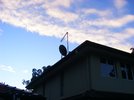
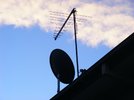
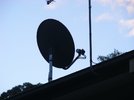
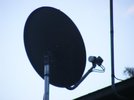
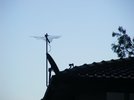
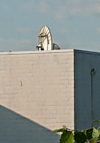
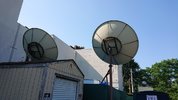
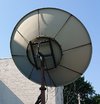
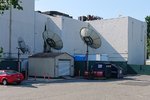
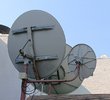
 )
)







